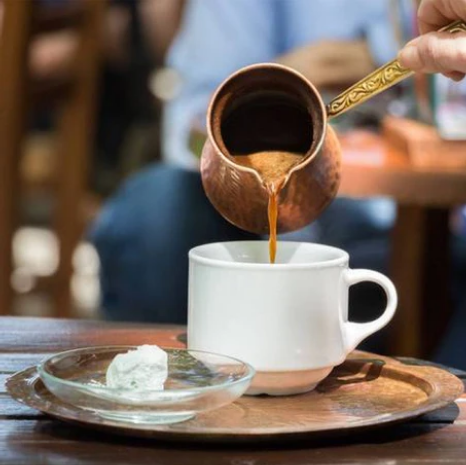Turkish coffee is not just a type of coffee; it’s a ritual, a symbol of hospitality, and a part of Turkey’s cultural heritage.
This unique beverage has a rich history dating back to the Ottoman Empire, and its cultural significance extends far beyond the borders of Turkey. The allure of Turkish coffee lies in its strong taste, the technique used in its preparation, and the traditions associated with its consumption.
Read on to to find out all about the traditions and technique surrounding Turkish coffee.
| Key Takeaways | |
|---|---|
| 1 | Turkish coffee is unique due to its preparation and brewing process, which involves brewing unfiltered coffee in a cezve and serving it with the grounds. |
| 2 | The tradition of Turkish coffee extends beyond the drink itself, symbolizing hospitality and friendship in Turkish culture, and even being used for fortune telling. |
| 3 | Making Turkish coffee at home is a rewarding experience that allows you to partake in a centuries-old tradition. With practice and patience, anyone can master the art of Turkish coffee brewing. |
The Tradition of Turkish Coffee
In Turkish society, coffee plays a significant role. It’s not just a drink to wake you up in the morning; it symbolizes hospitality and friendship. You’ll likely be offered a Turkish coffee when visiting a Turkish home. It’s a way of saying, “You’re welcome here.”

Turkish coffee also plays a central role in various traditional ceremonies and events. One of the most notable is during marriage proposals, where the prospective bride is expected to prepare and serve Turkish coffee to her suitor and his family.
Another fascinating tradition is fortune telling with Turkish coffee grounds. After drinking the coffee, it’s common to turn the cup upside down and let the remaining coffee grounds dry. The patterns left in the cup are then interpreted to predict the drinker’s future. This practice, known as tasseography, is a fun and popular pastime in Turkey.
The Technique of Making Turkish Coffee
The process of making Turkish coffee is as unique as the drink itself.
Start with fresh, finely ground coffee beans
The first step to making Turkish coffee is to grind the beans to a fine powder. The importance of the coffee grind cannot be overstated; it should be as fine as a cocoa powder for the best results.
Use a cezve
The next crucial element in the process is the cezve, a small, long-handled pot traditionally made of brass or copper. The cezve is where the coffee is brewed, and its shape and material contribute to the unique taste of Turkish coffee.
Add water, coffee, and sugar
The brewing process is slow and meticulous. The coffee, water, and sugar (if desired) are added to the cezve, which is then placed on a heat source.
Heat the mixture slowly
The coffee is heated slowly over low heat until it begins to froth.
Pour the froth into a cup
The froth is then distributed into each coffee cup, and the remaining coffee in the cezve is returned to the heat until it froths again. This process may be repeated several times to achieve the perfect foam.
Achieving the perfect foam is a vital part of making Turkish coffee. The foam adds to the taste and visual appeal of the coffee. It’s a sign of a well-prepared cup of Turkish coffee and is a skill that coffee lovers strive to perfect.
The technique of making Turkish coffee may seem complex, but with practice, anyone can master it. The result is a rich, strong coffee that is truly a delight to the senses. For more comprehensive information on Turkish coffee, visit Wikipedia’s page on Turkish coffee.

The Taste of Turkish Coffee
The taste of Turkish coffee is distinct and unforgettable. It’s rich, intense, and full-bodied, with a bitter and sweet flavor. The coffee is unfiltered, which means the fine coffee grounds are part of the drink, contributing to its unique texture and taste.
Turkish coffee is stronger and more robust than other types of coffee. It’s often likened to espresso due to its strength, but the taste is more complex, with a broader range of flavors.
The role of sugar and other additives in Turkish coffee is a matter of personal preference. Some people prefer their Turkish coffee sweet, adding sugar to the cezve before brewing. Others like it black, allowing the natural flavors of the coffee to shine. Spices like cardamom can also be added for an extra layer of flavor.
Conclusion
Turkish coffee has a global influence and popularity that extends far beyond the borders of Turkey. Its unique taste, the tradition associated with its preparation, and the communal culture surrounding its consumption have made it a beloved beverage worldwide.
Making Turkish coffee at home is a rewarding experience that allows you to partake in a centuries-old tradition. Perfecting your technique may take a few tries, but the result is well worth the effort. So why not give it a try? Brew a pot of Turkish coffee, invite some friends over, and enjoy this unique beverage’s rich taste and tradition.
FAQs
What is the secret behind Turkish coffee?
The secret behind Turkish coffee lies in its preparation and brewing process. The coffee is ground to a fine powder, brewed slowly in a cezve, and served unfiltered. This process allows for a unique, strong, and rich flavor that sets Turkish coffee apart from other types of coffee.
How to make Turkish coffee like a professional?
Making Turkish coffee like a pro involves mastering the brewing process. It includes getting the right grind consistency, heating the coffee slowly to create the perfect foam, and serving the coffee correctly. Practice and patience are crucial to mastering the art of Turkish coffee brewing.
What makes Turkish coffee different?
Turkish coffee differs from other coffee types in several ways. It’s brewed unfiltered in a cezve, which results in a stronger and thicker coffee. The grounds are left in the cup, adding to the unique taste and texture.
Is Turkish coffee stronger than espresso?
Regarding taste, Turkish coffee is generally stronger than espresso due to its brewing method. However, in terms of caffeine content, espresso usually contains more.
Why is salt sometimes added to Turkish coffee?
Adding salt to Turkish coffee is a regional tradition. It’s believed to enhance the flavor of the coffee and balance the bitterness.
What is the significance of the foam in Turkish coffee?
The foam in Turkish coffee is a sign of a well-prepared cup. It adds to the taste and visual appeal of the coffee. An excellent Turkish coffee should have a decent amount of foam on top.
How is Turkish coffee served traditionally?
Turkish coffee is traditionally served in small, espresso-sized cups. It’s often accompanied by a glass of water and a piece of Turkish delight or other sweet treats. The coffee is served hot, and it’s customary to let it sit for a moment ahead of drinking to allow the grounds to settle at the bottom of the cup.

Written by Carla – Coffee Writer and Researcher at MyCoffeeBeanz.com
Carla has a long association with coffee and one of her fondest childhood memories is the wonderful aroma of coffee beans ground daily by her Italian father to start his working day. As a full time writer and researcher in the coffee industry, Carla is committed to providing well researched and written coffee-related content for our readers. More about Carla
